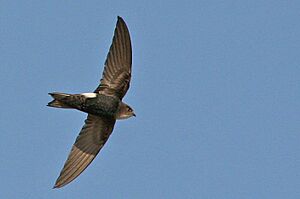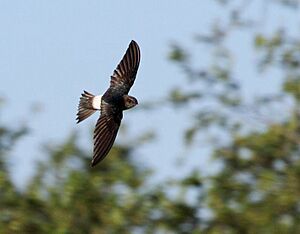Horus swift facts for kids
Quick facts for kids Horus swift |
|
|---|---|
 |
|
| Horus swift in South Luangwa National Park, Zambia | |
| Conservation status | |
| Scientific classification | |
| Genus: |
Apus
|
| Species: |
horus
|
The Horus swift (Apus horus) is a small bird. It belongs to the swift family, called Apodidae. You can find this bird in sub-Saharan Africa. The name "Horus" comes from an ancient Egyptian god. Horus was the god of the sun, and the son of Osiris and Isis.
Contents
About the Horus Swift's Name
Birds are given scientific names to help scientists identify them. The Horus swift was first officially described in 1869. This was done by a German explorer and bird expert named Theodor von Heuglin. He gave it the scientific name Cypselus horus.
The name horus comes from Ancient Egyptian stories. Horus was a very important god of the sun. Today, this swift is one of 20 types of swifts in the group called Apus. This group was named in 1777 by an Italian scientist, Giovanni Antonio Scopoli.
What Does the Horus Swift Look Like?
The Horus swift is about 13 to 15 centimeters (5 to 6 inches) long. It looks quite strong and solid. Most of its body appears blackish. However, it has a white patch under its chin and a white area on its lower back, called the rump.
It has a tail that is forked, meaning it splits into two points. Its flight style is fluttery, similar to a little swift. The little swift has a squarer tail and more white on its rump. Another bird, the white-rumped swift, has a deeper forked tail and a thinner white band. The Horus swift's call sounds like a buzzing peeeeooo, peeeeooo.
Where Do Horus Swifts Live?
The Horus swift lives and breeds in sub-Saharan Africa. This is the part of Africa south of the Sahara Desert. They are found in a large area from eastern and southern South Africa. Their range extends north to southern Zambia and central Mozambique.
They have also recently started living in the De Hoop Nature Reserve in South Africa. You can also find them in other parts of sub-Saharan Africa, but not always in a continuous line. For example, there are many in the mountains of Ethiopia and from central Kenya into Uganda.
Some Horus swifts in South Africa are migratory. This means they fly further north for the winter. Other groups of Horus swifts stay in one place. They only move around locally.
Reproduction and Life Cycle
Horus swifts build their nests in old burrows. These burrows are often made by other birds like bee-eaters, ground woodpeckers, kingfishers, and martins. These tunnels are usually found in sandy banks, which can be natural or man-made.
The swift builds a flat nest inside the tunnel. It uses plants and hair, glued together with its own saliva. The female swift lays between 1 and 4 eggs. The eggs are kept warm for about 28 days until they hatch. The young birds are ready to fly after about 6 weeks.
Horus swifts do not live in large groups. However, because they use burrows in sandy banks, several pairs might nest near each other. They usually find food in the middle layers of the air over nearby areas. They tend to avoid large towns.



